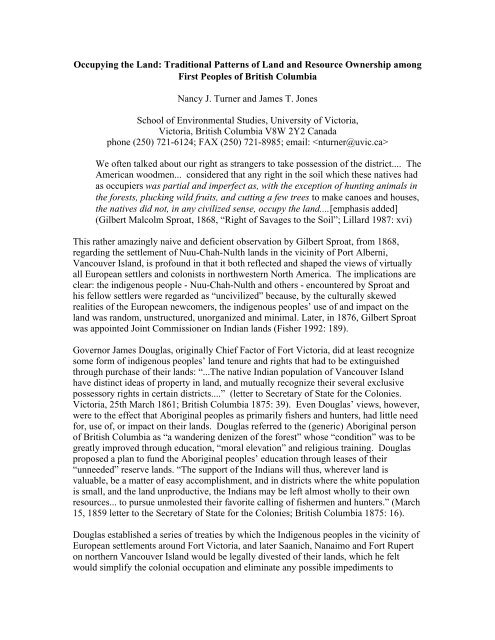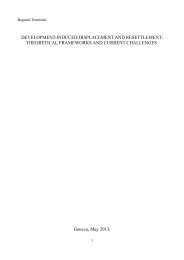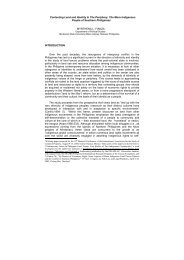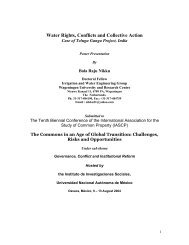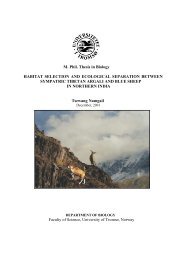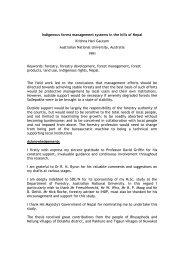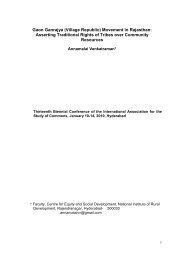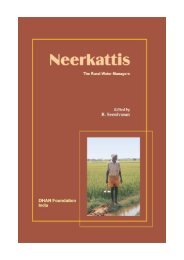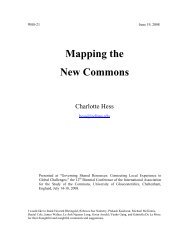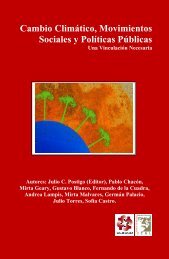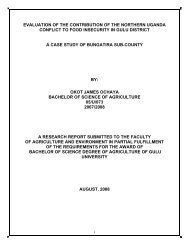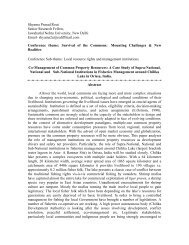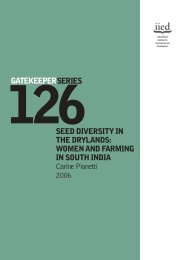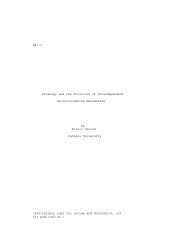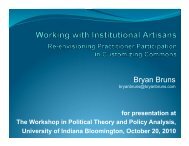Occupying the Land - Digital Library Of The Commons
Occupying the Land - Digital Library Of The Commons
Occupying the Land - Digital Library Of The Commons
You also want an ePaper? Increase the reach of your titles
YUMPU automatically turns print PDFs into web optimized ePapers that Google loves.
settlement. Notably, <strong>the</strong> template for <strong>the</strong> so-called “Douglas treaties” was drawn from <strong>the</strong>wording of <strong>the</strong> 1840 Treaty of Waitangi negotiated by <strong>the</strong> British government with <strong>the</strong>Maori of New Zealand, where similar philosophies and misunderstandings were imposed(Arnett 1999: 31). <strong>The</strong> Secretary of <strong>the</strong> Hudson’s Bay Company wrote to James Douglas,“ in your negotiations with [<strong>the</strong> chiefs of <strong>the</strong> tribes]... you are to consider <strong>the</strong> natives as<strong>the</strong> rightful possessors of such lands only as <strong>the</strong>y are occupied by cultivation, or hadhouses built on [emphasis ours], at <strong>the</strong> time when <strong>the</strong> Island came under <strong>the</strong> undividedsovereignty of Great Britain in 1846. All o<strong>the</strong>r land is to be regarded as waste, andapplicable to <strong>the</strong> purposes of colonization...” (Archibald Barclay to James Douglas, May16, 1850, cited by Arnett 1999: 32).As pointed out by Arnett (1999: 32), <strong>the</strong> British perspective was influenced by social<strong>the</strong>ory of <strong>the</strong> day, in particular that propounded by Vattel, an eighteenth-century Frenchlegalist, who argued that cultivation alone gave <strong>the</strong> right to hold title to land. Hunting orfood ga<strong>the</strong>ring he considered indolent forms of existence. “Those who yet hold to <strong>the</strong> idlemode of life,” wrote Vattel, “usurp more land than <strong>the</strong>y would require with honest labour,and cannot complain if o<strong>the</strong>r nations, more laborious and too much pent-up, come andoccupy any portion of it” (quoted by Arnett 1999:32).Archibald Barclay sent his version of <strong>the</strong> Deed developed for <strong>the</strong> Treaty of Waitangi,with its blanket wording, used by Douglas in all of <strong>the</strong> treaties he set out, including <strong>the</strong>excerpt, “<strong>The</strong> condition of, or understanding of <strong>the</strong> sale is this, that our village sites andEnclosed Fields are to be left for our own use, for <strong>the</strong> use of our Children, and for thosewho may follow after use... it is understood however that <strong>the</strong> land itself with <strong>the</strong>se smallexceptions becomes <strong>the</strong> Entire property of <strong>the</strong> White people for ever; it is also understoodthat we are at liberty to hunt over <strong>the</strong> unoccupied lands, and to carry on our fisheries asformerly....” (British Columbia 1875: 5-11).<strong>The</strong>se treaties demonstrated that <strong>the</strong> Europeans were largely ignorant of aboriginal landuse and <strong>the</strong> seasonal exploitation by indigenous peoples of a wide variety of foodresources from many locations and habitats within <strong>the</strong>ir traditional territories. Laterofficials were to express, even more vigorously, <strong>the</strong> view that <strong>the</strong> “Indians” did not use orneed <strong>the</strong> land. In 1867, Joseph W. Trutch, who was appointed Chief Commissioner of<strong>Land</strong>s and Works for British Columbia in 1864, wrote, in a long statement on LowerFraser River Indian Reserves,<strong>The</strong> Indians regard <strong>the</strong>se extensive tracts of land as <strong>the</strong>ir individual property; butof by far <strong>the</strong> greater portion <strong>the</strong>reof <strong>the</strong>y make no use whatever and are not likelyto do so; and thus <strong>the</strong> land, much of which is ei<strong>the</strong>r rich pasture or available forcultivation and greatly desired for immediate settlement, remains in anunproductive condition - is of no real value to <strong>the</strong> Indians and utterly unprofitableto <strong>the</strong> public interests. (Emphasis added).And, later in <strong>the</strong> same document,<strong>The</strong> Indians have really no right to <strong>the</strong> lands <strong>the</strong>y claim, nor are <strong>the</strong>y of any actualvalue or utility to <strong>the</strong>m... It seems to me... both just and politic that <strong>the</strong>y should be2
confirmed in <strong>the</strong> possession of such extents of lands only as are sufficient for<strong>the</strong>ir probable requirements for purposes of cultivation and pasturage, and that<strong>the</strong> remainder of <strong>the</strong> land now shut up in <strong>the</strong>se reserves should be thrown open topre-emption... firmness and discretion ... to convince <strong>the</strong> Indians that <strong>the</strong>Government intend only to deal fairly with <strong>the</strong>m and <strong>the</strong> whites, who desire tosettle on and cultivate <strong>the</strong> lands which <strong>the</strong>y (<strong>the</strong> Indians) have really no right toand no use for...” (Joseph W. Trutch, 28th August 1867; emphasis added).Trutch held similar views on o<strong>the</strong>r First Peoples’ territories, such as those of <strong>the</strong>Secwepemc of Kamloops and Shuswap: “...<strong>the</strong> claims of Indians over tracts of land, onwhich <strong>the</strong>y assume to exercise ownership, but of which <strong>the</strong>y make no real use, operatevery materially to prevent settlement and cultivation...” (Joseph W. Trutch, 20th Sept1865; British Columbia 1875).In <strong>the</strong> end, Douglas’ Treaties, and <strong>the</strong> reserve system imposed on First Peoples acrossBritish Columbia and elsewhere were as “partial and imperfect” as Sproat’scharacterizations of aboriginal occupation, but <strong>the</strong>y were <strong>the</strong> inevitable outcome of <strong>the</strong>predominant colonial view. It has had repercussions for First Peoples and all o<strong>the</strong>rs as,nearly 150 years later, we struggle with <strong>the</strong> same uninformed and deeply embeddedbureaucratic attitudes to renegotiate agreements and “modern treaties” based on a fairer,more realistic assessment of indigenous peoples’ original occupation and use of <strong>the</strong>irtraditional lands and waters balanced with <strong>the</strong>ir future needs, both economic and cultural.In this paper, we will examine historical and ethnographic sources, toge<strong>the</strong>r with oralaccounts from indigenous people in B.C. to try to characterize <strong>the</strong> range of systems ofterritoriality and occupation of lands and resource use of indigenous cultures in B.C. from<strong>the</strong> pre-colonial era and to determine how land tenure is related to “a larger system ofrights, obligations and rules pertaining to land and resource use and proprietorship”(Berkes 1999: 51). We will <strong>the</strong>n address <strong>the</strong> relationship between <strong>the</strong>se systems andtraditional resource management practices. Finally, we will discuss <strong>the</strong> potential forreinstatement of traditional proprietorship systems as a means of enhancing andimproving land and resource management for both aboriginal and non-aboriginalcommunities.Traditional Patterns of Territoriality and Resource Ownership in British ColumbiaTo date, <strong>the</strong>re have been many characterizations of traditional ownership andproprietorship systems among various First Nations in British Columbia. <strong>The</strong>se aregenerally summarized in <strong>the</strong> chapters of Helm (1981), Suttles (1990), and Walker (1998),and Richardson (1992); see also Sutton 1975; Turner et al. in press 2000). We draw on<strong>the</strong>se descriptions to provide an overview of <strong>the</strong> specific traditions for controlling landand resources for a range of cultural and linguistic groups of British Columbia in Table 1(Map, Figure 1).3
Indigenous Group(Language Family);ReferencesCentral Coast Salish:Squamish, Halkomelem,Nooksack, Nor<strong>the</strong>rn Straits,and Clallam (Salish)(Suttles 1990: 463-465;Hill-Tout 1900:491)Nor<strong>the</strong>rn Coast Salish:Sechelt, Comox (Salish);(Barnett 1955: 25; Kennedyand Bouchard 1983: 64,1990: 447)Nuxalk (Salish) (Kennedyand Bouchard 1990: 325-330)Nuu-Chah-Nulth, Ditidaht(Wakashan) (Arima andDewhirst 1990: 399-401)Kwakwaka’wakw,(Wakashan) (Daisy Sewid-Smith, Chief Adam Dick;Codere 1990: 364; Galois,1994)Notations on <strong>Land</strong> and Resource ProprietorshipA range of tenure and ownership, from generalcommunity use and occupancy to family control; ingeneral, members of a kin group, descendants from acommon notable ancestor, shared inherited rights toresources, such as fishing sites, and o<strong>the</strong>r property; <strong>the</strong>management of resources was often by a designated chiefor household head; permission to use by o<strong>the</strong>rs requiredfrom <strong>the</strong> owners; in many instances <strong>the</strong>re were noexclusive rights recognized for individuals or families;resource use rights, when <strong>the</strong>y did occur, were inheritedthrough both parental lines (see Detailed Model)Extended family units, “local groups” or lineagessometimes owned and controlled specific resourceharvesting sites, such as fishing sites, over various partsof <strong>the</strong> group’s territory; most lands were used andoccupied communally; harvesting sites sometimesinherited within families; inheritance through bothparental linesTerritories and specific resource harvesting sites within<strong>the</strong>m owned and controlled by lineages or descentgroups, those having a common ancestor as determinedfrom a single origin story with authority invested in achief or o<strong>the</strong>r designates (e.g. <strong>the</strong> River Guardian);bilateral kinship, with people often claiming membershipand privileges of more than one descent group; onlysome men had ancestral prerogatives to be professionalhunters; ownership of fish weirs originally by descentgroups, but more recently by individualsAll resource sites and designated territories owned bylocal groups, and <strong>the</strong>ir use specifically controlled anddirected by hereditary chiefs; chiefs received a tributefrom all those using <strong>the</strong>ir resource sites, and wereexpected to hold a feast with <strong>the</strong>se goods. Rights toresources and o<strong>the</strong>r property could be accessed by gift,by marriage or in war or were inherited by one or morechildren, usually males (see Detailed Model)over 30 tribes, each made up of (usually) three or moreclans (numayms), membership in which was determinedby descent from a common supernatural ancestor asrecounted in origin stories; each clan owned house sitesin <strong>the</strong> village and various resource harvesting sites aswell as o<strong>the</strong>r property; <strong>the</strong>se were held underproprietorship of <strong>the</strong> hereditary chief; each tribe had4
easily accessible food resources; members traveled over awide area by canoe to access specific resource sites of itsclans; bilateral kinship heredity meant that a family couldclaim multiple resource harvesting areasHeiltsuk, Haihais,Oowekeeno (Wakashan);(Hilton 1990: 316-317)Haisla (Wakashan)(Hamori-Torok 1990: 308-309)Haida (Haida) (Blackman1990: 248-252)Tlingit (Alaska; Tlingit) (deLaguna 1990: 212-213)Coast Tsimshian, SouthTsimshian, Gitxsan, Nisga’a(Tsimshian) (Halpin andSeguin 1990: 274-276; Dalyand Vast ms. 1999; GisdayWa and Delgam Uukw1989; Weinstein 1994)Wit’suwit’en (Athapaskan)(Daly and Vast ms. 1999;Gisday Wa and DelgamUukw 1989; Weinstein1994)Tahltan, Kaska, Tagish,Dene-thah, Dunne-za,Basic social/political unit was a lineage, local group,whose members were descended from a commonancestor but mainly, determined by residence; manyresource sites were owned and controlled by suchlineages, represented by hereditary chiefs. Use rightswere also controlled by families within <strong>the</strong> local group orby crest groups or clans (not strictly exogamous ormatrilineal, as in <strong>the</strong> nor<strong>the</strong>rn Nations). <strong>The</strong> local groupssometimes combined into tribesSix matrilineal exogamous clans (Eagle, Beaver, Raven,Orca/Blackfish, Salmon/Wolf and Crow, held territorialrights and controlled rights to harvest resourcesLineages or families, headed by hereditary chief (about50 lineages within Raven and Eagle exogamous moietiesor clans) owned and controlled resource rights, includingsalmon spawning streams, patches of edible plants, cedartree stands and bird nesting areas, as well as house sitesand houses. Territories and harvest sites could betransferred through gift or debt from one lineage toano<strong>the</strong>r; inheritance matrilinealLineages, or clans (about 30, within Raven andWolf/Eagle exogamous moieties) and under <strong>the</strong>m,houses, possessed territories including resource rights;Clan chiefs and “house owners” were administrators of<strong>the</strong> group’s property; could assign fishing spots, controlhunting seasons; territories could be gifted or taken inwar; inheritance was matrilinealLineages or houses (wa.lp, or wilp) within fourexogamous tribes or clans of matrilineal descent were <strong>the</strong>owners of fishing, hunting and ga<strong>the</strong>ring territories andlocalities, with rights, control and responsibilitiesinvested in <strong>the</strong> chief and his (or rarely her) counselorchiefs on behalf of <strong>the</strong> group. Use rights were oftengifted or taken as payment for debtsClosely follows Gitxsan traditions; tracts of land held bya house group (yex) of matrilineal kin, with rights andresponsibilities invested in <strong>the</strong> chief and or her counselorchiefs on behalf of <strong>the</strong> groupExogamous family groups as basic camp clusters orhunting groups with larger seasonal ga<strong>the</strong>rings. Control5
Sekani, Dakelh or Carrier,Tsilhqot’in (Athapaskan) ;(Helm 1981)Stla’tl’imx or Lillooet,Secwepemc or Shuswap,Nlaka’pamux or Thompson,Okanagan, Sinixt (Salish)(Walker 1998)Ktunaxa (Kootenay)(Brunton 1998)by headmen over some fishing sites and later, beavercreeks in some areas. Matrilineal inheritance. Groups freeto roam and hunt within tribal territories wherever noo<strong>the</strong>r family harvesting was currently in progressIndividuals were part of a large, loose network of kindrawn from both parental lines; villages were primarypolitical units, with decision-making by informalpolitical consensus; village headman with semiformalinheritance of position might guide and direct harvestingactivities; villagers toge<strong>the</strong>r controlled access to fishingsites and to o<strong>the</strong>r resource areas; general control overharvesting through First Foods ceremonies; although keyharvest areas would be hosted and controlled by localbands, highly active and extensive intergroupconnections allowed harvesting access and exchange ofresources over wide areas, and proprietary rights overlarge territories might be held by a group of villages incommon<strong>The</strong> household, an extended family, was <strong>the</strong> basic socialunit, with <strong>the</strong> oldest, most experienced man being <strong>the</strong>recognized leader, a position that was somewha<strong>the</strong>reditary. He coordinated day-to-day activities in <strong>the</strong>winter villages with decision-making aided by a council;special activities would be lead by temporary appointedleaders; fishing, fowling, hunting leaders were appointedand placed in charge of specific harvesting activitiesincluding first-fruits ceremonies. Households wereorganized into villages or bands, whose territories werenot rigidly defined. Resource harvesting took place overa wide areaTable 1. Patterns of Territoriality and Resource Ownership for Various First Nations ofBritish Columbia. (Map, Figure 1) (Note that although <strong>the</strong> descriptions of proprietorshipare in <strong>the</strong> past tense, some of <strong>the</strong>se traditions persist and are practiced today, at <strong>the</strong>beginning of <strong>the</strong> 21st century).Two prevailing models of land and resource proprietorship emerge from <strong>the</strong>characterizations presented in Table 1. <strong>The</strong> first is more typical for <strong>the</strong> peoples of <strong>the</strong>sou<strong>the</strong>rn part of <strong>the</strong> Northwest Coast region, and those of inland areas, where <strong>the</strong>re aregenerally less rigid controls of land occupancy and resource use for those within a giventribal territory and those identified as kin and allies. <strong>The</strong> traditional Central Coast Salishposition on land occupancy is an example of this model.<strong>The</strong> second model, also with many variations, is a more strictly and rigorously definedsocial system of land use and ownership by specific descent groups, lineages, “houses” orclans, each headed by a Hereditary Chief and each laying specific claim to particulartracts of land with strictly defined boundaries, usually at <strong>the</strong> watershed scale. This modelapplies to <strong>the</strong> systems for <strong>the</strong> Nuu-Chah-Nulth and most central and nor<strong>the</strong>rn Northwest6
Coast peoples as well as for <strong>the</strong> Gitxsan and Witsuwit’en fur<strong>the</strong>r inland. <strong>The</strong> Nuu-Chah-Nulth hahuulhi system is presented as an example.Central Coast Salish Example:Loosely Defined, Non-Exclusive Communal <strong>Land</strong> Use with Family Ownership of SomeSpecific Resource Sites and Harvesting Equipment<strong>The</strong>re were some variations on <strong>the</strong> extent of land and resource ownership in placeamongst various Coast Salish peoples. Ownership of land and resources is held to havebeen conceptually different from ownership of personal property such as canoes,weapons, implements, slaves by individuals, or even from <strong>the</strong> highly-valued familyownednames, ceremonial prerogatives, songs, dances and medicine recipes (Kennedy1993: 69).Jenness (1934-1935: 37) characterized <strong>the</strong> situation as follows:Every Saanich [Straits Salish] (and indeed almost every Coast Salish) village...was a unit by itself, linked by economic and cultural ties, and by intermarriage,with neighbouring villages, but politically quite distinct.<strong>The</strong> real political unit, was, <strong>the</strong>refore, not <strong>the</strong> village, but <strong>the</strong> big house occupiedby a number of kinsfolk - an enlarged or genealogical 'family' to which <strong>the</strong>Saanich applied <strong>the</strong> term hunit'se'lakum, [or...] ...House. Each Saanich house...possessed its own long shed-roofed dwelling, its own camas [Camassia spp.]beds on Galiano and neighbouring islands, its own fishing place on <strong>the</strong> beach atPoint Roberts [and elsewhere], its own set of ancestral names or titles, and its ownstock of legends, songs and medicinal remedies.... On <strong>the</strong> o<strong>the</strong>r hand, <strong>the</strong> sea near<strong>the</strong> villages, <strong>the</strong> hunting grounds and berry patches round about, were commonproperty; any villager, whatever his station in life, might fish and hunt whereverhe wished within <strong>the</strong> village territory." (Jenness 1934-1935: 38).Even around <strong>the</strong> village sites, families had customary harvesting places where <strong>the</strong>y hadprimacy; <strong>the</strong>se arrangements are still in place at <strong>the</strong> present time (R. Morris, pers. comm.to NT, 1999). Burning and clearing of specific tracts of land would have been communalefforts under direction of <strong>the</strong> household head or a designate.Among <strong>the</strong> Upriver Sto:lo (Halkomelem) of <strong>the</strong> Fraser Valley, too, land and resourceareas were not privately or exclusively owned, and <strong>the</strong>re were no precise boundaries forvillages or tribal districts. Resources were shared or available for use by anyone in <strong>the</strong>group. However, people generally had a proprietary interest in <strong>the</strong> lands and waters near<strong>the</strong>ir villages and would protect <strong>the</strong>se areas against intrusion by strangers or trespassers.Also, among <strong>the</strong> Upper Sto:lo, salmon dip-net stations were owned by heads of families.<strong>The</strong> dip-net itself was owned by <strong>the</strong> fishing station owner, but was left at <strong>the</strong> water's edgefor o<strong>the</strong>rs to use if <strong>the</strong>y needed to (Duff 1952:77).Suttles confirmed that among <strong>the</strong> Katzie (Halkomelem), streams where salmon weirswere constructed or where dipnets were used, were <strong>the</strong> joint property "of several7
families," and <strong>the</strong> use by o<strong>the</strong>rs required first seeking permission from <strong>the</strong> head man, arequest that would not usually have been denied (Suttles 1955:22). Permission was alsosaid to be required of outsiders who wished to ga<strong>the</strong>r bog cranberries (Vacciniumoxycoccus) and dig wapato (Sagittaria latifolia) in Katzie territory, some of which weretribally owned and o<strong>the</strong>rs of which belonged to particular families. An individual,usually a young man, was instructed to watch <strong>the</strong> ripening of <strong>the</strong> fruit and to ensure thatvisitors did not pick <strong>the</strong> berries while still green. Suttles (1955:27) contended that..."identification with a rich cranberry bog was its own reward in that it permitted <strong>the</strong>owners to play <strong>the</strong> role of hosts."<strong>The</strong> Chilliwack (Halkomelem) and Nooksack held an explicit perception of huntingterritory, however (Hill-Tout 1903:6; Kew 1979:4; Duff 1952:77). Some prohibitionswere held towards specific neighbouring groups and not o<strong>the</strong>rs. For example, Nooksackwere said to have expressed a sense of outrage when Nlaka’pamux (Thompson) hunterswere found poaching mountain-goat in Nooksack territory (Coleman 1869, cited inAmoss 1972: 11), but did not mind Lummi hunters (Stern 1934: 50). Smith (1950: 337)noted a case where a Nooksack family which owned plots at a particular prairie for"Indian carrot" [possibly Perideridia gairdneri].. were caught trespassing upon ano<strong>the</strong>rfamily's area, resulting in "big fights."Although Barnett (1955: 252) found Musqueam Halkomelem, Island Halkomelem andSaanich consultants unaware of family-owned resource harvesting areas, Nor<strong>the</strong>rn Straits(including Saanich) people did, in fact, have "separate and exclusive fishing, hunting,root and berry grounds," as opposed to Island Halkomelem, according to Jenness. Jenness(1934-1936b: 170, 173) also explained that <strong>the</strong> Cowichan Halkomelem had huntingterritories in common, but each village constructed and maintained its own fish weir,while each family visited its own [bracken] fern-root (Pteridium aquilinum) and camasdigging area. Nanaimo Halkomelem families also had <strong>the</strong>ir own camas and fern rootbeds, but <strong>the</strong> salmon weir on <strong>the</strong> Nanaimo River was owned by a headman of <strong>the</strong> highestranking local group (Barnett 1935-36L 67, 117).Stern (1934: 43, 47) considered <strong>the</strong> Lummi's (Straits Salish) annual use of camas beds tobe customary, but not exclusive, although he did note that some clam beds were ownedand cultivated by families removing rocks to facilitate digging. Suttles (1951: 60-61)recorded ownership of camas beds among Samish and Saanich, but not Songhees [allStraits Salish], who, he reports, were joined by <strong>the</strong> Samish to dig <strong>the</strong>se bulbs. Heconfirmed private possession of certain clam beds by Lummi, Samish and possiblySemiahmoo. Boas (1890:568) reported that among <strong>the</strong> Nor<strong>the</strong>rn Straits Salish, "everygens [local group] had its own fishing ground. <strong>The</strong> chief of <strong>the</strong> gens will invite a numberof families to help him catch salmon.”Despite <strong>the</strong> variations across cultural, linguistic and geographic space, a trend is evidentfrom <strong>the</strong>se various Salishan ethnographic descriptions: harvesting of resources that werevery localized, or that required “cultivation” or construction and <strong>the</strong>refore a particularexpenditure of energy over and above <strong>the</strong> harvesting itself, was usually subject to someform of control and ownership, but this was assumed within <strong>the</strong> context of a ra<strong>the</strong>regalitarian system of collective use and occupation of a group’s territory. As Barnett8
(1955: 252) noted, “villagers were free to roam, providing <strong>the</strong>y did not interfere witho<strong>the</strong>rs.”In 1967, Saanich elder Christopher Paul explained to ethnography student MargueriteBabcock how Saanich families established proprietorship over a camas patch:<strong>The</strong> way that <strong>the</strong> family group... would establish claim to a plot of land [for camasharvesting] would be by clearing it. Once a family cleared a plot, it would "justnaturally" become <strong>the</strong>ir plot to use.... This clearing was done in <strong>the</strong> fall or springbefore <strong>the</strong> ga<strong>the</strong>ring season... in those seasons <strong>the</strong> soil was soft from <strong>the</strong> heavyrains, but not muddy (or frozen) as in <strong>the</strong> winter... <strong>The</strong> plot from which <strong>the</strong> bulbswere to be ga<strong>the</strong>red would be cleared of stones, weeds, and brush, but not of trees.<strong>The</strong> stones would be piled up in a portion of <strong>the</strong> plot where <strong>the</strong>re were no camasplants growing, and <strong>the</strong> brush would be piled to one side, left to rot or to beburned...; <strong>the</strong> bushes was actually uprooted, not just cut down... <strong>The</strong> purpose of<strong>the</strong> clearing, said Christopher Paul, was to make <strong>the</strong> camas easy to clear [sic: dig?]when <strong>the</strong> camas was ga<strong>the</strong>red intensively. <strong>The</strong> piles of stones on <strong>the</strong> plots are <strong>the</strong>remains or "markers" of <strong>the</strong> plots... however Christopher Paul doesn't know howor if <strong>the</strong> Indians set about marking off <strong>the</strong>ir plots o<strong>the</strong>r than clearing <strong>the</strong>m. ... hethinks that <strong>the</strong>se plots may have been cleared every year before <strong>the</strong>ir use, in orderto facilitate <strong>the</strong> ga<strong>the</strong>ring of <strong>the</strong> camas bulbs.... (quoted in Babcock, Marguerite1967: p. 5).If gear or equipment were involved in harvesting, <strong>the</strong> person who owned it generallycontrolled its use and received <strong>the</strong> largest or best portion of <strong>the</strong> harvest. For example, inone situation, hunting ducks with a net strung across two trees at Westholme (an IslandHalkomelem community), four men participated in <strong>the</strong> harvest: one drove <strong>the</strong> ducks, oneman was stationed in each tree, “and <strong>the</strong> net-owner supervised <strong>the</strong> operations” (Jenness1934-1935: 13). Similarly, in fishing, "A weir belonged to <strong>the</strong> five or six men who builtit, each of whom commonly set against it three or four traps.” (Jenness 1934-1935: 18).However, Jenness added that it was understood that o<strong>the</strong>r men in <strong>the</strong> community mightset <strong>the</strong>ir own traps at <strong>the</strong> weir as soon as <strong>the</strong> owners had satisfied <strong>the</strong>ir needs. Thus, <strong>the</strong>rewere both proprietary rights, and communal use for <strong>the</strong> same fishing location.A similar situation was reported for purse-net fishing:Because one man alone could never make a purse-net long enough for sockeyeand humpbacked [salmon], several Saanich families cooperated by makingsections that could be joined toge<strong>the</strong>r at <strong>the</strong> fishing grounds. <strong>The</strong> leader of <strong>the</strong>group <strong>the</strong>n supervised <strong>the</strong> fishing, appointing one man to watch... which way <strong>the</strong>shoals were running, and apportioned <strong>the</strong> catch equally among <strong>the</strong> severalfamilies, without regard to <strong>the</strong>ir social rank. Each family <strong>the</strong>n dried its share onits own rack. Not until all <strong>the</strong>ir requirements were satisfied, did <strong>the</strong> leader providefor himself, but <strong>the</strong>reafter he appropriated <strong>the</strong> entire catch, which his followers cutup and dried for him. (Jenness 1934-1935: 18).Suttles (1960:300) reported that for sturgeon traps and salmon traps of <strong>the</strong> Musqueam(Halkomelem), <strong>the</strong> catch could be taken freely by family members, but all o<strong>the</strong>rs had to9
ask permission to use <strong>the</strong> traps from those who built <strong>the</strong>m. Gun<strong>the</strong>r (1927:199) reportedthat Clallam salmon traps were owned by "<strong>the</strong> chief of <strong>the</strong> village, who tends it at night,leaving it during <strong>the</strong> day-time for his poor relatives who have not traps of <strong>the</strong>ir own."Deer-nets and deer-pits were likewise owned property. <strong>The</strong>ir operation was directed by<strong>the</strong> owner, but sites where <strong>the</strong>y were situated were not necessarily owned. As notedpreviously, aerial duck-nets were owned by families, as were <strong>the</strong> poles used to erect <strong>the</strong>m,but <strong>the</strong> sites where <strong>the</strong>y were erected were used by several tribes in common (Suttles1951:72). Suttles (1990:459), however, suggests that such sites were formerlyindividually owned.<strong>The</strong>se ownership traditions were closely intertwined with seasonal rounds, <strong>the</strong>movements of people over <strong>the</strong> harvest season from one site to ano<strong>the</strong>r where <strong>the</strong>y hadcustomary or culturally recognized rights. Jenness (1934-1935: 70) reported, "Wintervillage sites were situated within an area where people obtained large portions of <strong>the</strong>irfood and materials, and which <strong>the</strong>y identified using names in <strong>the</strong>ir own language. Agroup’s territory is commonly identified by applying <strong>the</strong> suffix /-ulh/ meaning ’of orbelonging to’... One’s territory is also <strong>the</strong> landscape imbued with oral tradition...Ownership was expressed individually as <strong>the</strong> right to use resources in a multitude ofareas, and was independent of proprietary feelings for one's tribal territory.”<strong>The</strong> East Saanich [Tsawout], <strong>the</strong> Songish [Legwungen] and those near Chemainusfollowed practically <strong>the</strong> same routine as <strong>the</strong> West Saanich; <strong>the</strong>y all left <strong>the</strong>ir main villagesin <strong>the</strong> middle of summer and netted sockeye and humpbacked salmon on <strong>the</strong> mainland,off <strong>the</strong> mouth of <strong>the</strong> Fraser River, as reported by Jenness (1934-1935:18). Also, "If <strong>the</strong>wea<strong>the</strong>r was warm, many of <strong>the</strong> [Saanich] people left <strong>the</strong> village and camped near <strong>the</strong>ircamas grounds on San Juan Island, using for shelter ei<strong>the</strong>r a few boards taken from <strong>the</strong>irhouse, or rush huts (Jenness 1934-1935: 7). <strong>The</strong> Suneymexw (“Solachwan”) people of <strong>the</strong>Nanaimo area, according to Jenness (1934-1935: 9), occupied <strong>the</strong>ir village until aboutApril, “when <strong>the</strong>y joined <strong>the</strong> o<strong>the</strong>rs in moving out to False Narrows and Gabriola Islandto fish for cod, grilse and o<strong>the</strong>r species, to hunt seals and seal-lions and to ga<strong>the</strong>r clamsand camas; for every family had its own bed of camas on Gabriola Island.”<strong>The</strong> Cowichan Halkomelem, according to Jenness (1934-1935: 8), had no fishing rightson <strong>the</strong> mainland, but only over <strong>the</strong> waters immediately adjacent to <strong>the</strong>ir shore and aroundMayne and Saltspring Islands. Jenness added that at Point Roberts, on <strong>the</strong> Mainland southof Tsawwassen, where Saanich families went to fish, each family dried its fish, year afteryear, in <strong>the</strong> same spot, and <strong>the</strong>y left <strong>the</strong>ir stone net-sinkers at this location to be used <strong>the</strong>following year. <strong>The</strong>re was a careful distribution of fish with a special counting system(Jenness 1934-1935: 18). Actually, <strong>the</strong>re are o<strong>the</strong>r reports that <strong>the</strong> Cowichan did haverights to harvest sites on <strong>the</strong> Mainland. Arvid Charlie (pers. comm., 1999) stated that <strong>the</strong>people from Cowichan not only had property and resource harvesting sites on <strong>the</strong> GulfIslands, but that <strong>the</strong>y owned an island near Port Moody along <strong>the</strong> Fraser River, and went<strong>the</strong>re specifically to harvest cat-tails. It seems unlikely that <strong>the</strong>y would not have taken thisopportunity to fish as well.In any case, as noted by Kennedy (1993), Jenness (1934-1935), Suttles (1990) and o<strong>the</strong>rs,<strong>the</strong>re was such an extensive network of affinal ties from inter-village and inter-nationmarriages among <strong>the</strong> Central Coast Salish, that most people had relations on whom <strong>the</strong>y10
could count for resource harvesting privileges throughout <strong>the</strong> region. Arvid Charlie (pers.comm. to NT 1999) noted that he personally has relations with <strong>the</strong> Snuneymexw(Nanaimo), Musqueam, Chemainus (all Halkomelem), Tsawout, Tsartlip, andLekwungen, as well as with American communities like <strong>the</strong> Lummi and Semiahmoo (allStraits). Fur<strong>the</strong>rmore, he said, one of his relatives, a Semiamhoo woman, routinely cameto <strong>the</strong> village at Cowichan Bay, and stayed in a part of <strong>the</strong> settlement known as “LittleSemiamhoo” because that was owned and occupied by <strong>the</strong> people from that village.Nuu-Chah-Nulth “HaHuulhi” Example:More Rigorous Proprietorship of Large Areas Through Hereditary Chiefs withCommunity Consultation and Assignment of Specific Rights Within to Sub-Chiefs andO<strong>the</strong>rsIn Nuu-Chah-Nulth traditions, <strong>the</strong> Chiefs’ proprietary rights to territory and resources areknown as hahuulhi. <strong>The</strong>re are comparable systems among <strong>the</strong> neighbouringKwakwaka’wakw and more nor<strong>the</strong>rly coastal groups. Hahuulhi ...is described byHereditary Chief of Ahousaht Earl Maquinna George (pers. comm. to NT, May 10,1996).Hahuulhi ...is a word equivalent to, if not a stronger word, than sovereignty. <strong>The</strong>word is used by hereditary chiefs of <strong>the</strong> Nuu-Chah-Nulth for aboriginal right,ownership, and territory. It's a chieftainship's role to hold that hahuulhi as a sacredright. Now today <strong>the</strong>y call it aboriginal right. And ...besides salmon streams thatwere owned by hereditary owners. <strong>The</strong>y had specific areas. <strong>The</strong>y couldn't gobeyond <strong>the</strong>ir own realm of boundary lines because <strong>the</strong>re were o<strong>the</strong>r tribes on eachside of <strong>the</strong> nation or territory because <strong>the</strong>re were known places that marked offterritorial area. <strong>The</strong>re is a fine line between two nations. On each side of <strong>the</strong>Ahousaht Nation was ...on <strong>the</strong> south side, <strong>the</strong> Tla-o-qui-aht Nation, south side toMeares Island, and Bedwell Sound and up into <strong>the</strong> mountains beyond StrathconaPark on Vancouver Island. On <strong>the</strong> o<strong>the</strong>r side, <strong>the</strong> northwest side, <strong>the</strong> borderbetween <strong>the</strong> Hesquiaht Nation, Hesquiaht Point and in behind Cannon [Konni]Lake. And going into <strong>the</strong> Talbot Range, Median Lake. Big area and a big territory.[At Potlatches]... <strong>The</strong>y didn't give ownership [away] but <strong>the</strong>y did give certain rightsto hereditary chiefs. Sometimes <strong>the</strong> right to catch fish, but not to own <strong>the</strong> creek.And <strong>the</strong>y talked about it at <strong>the</strong> potlatch because big name hereditary chiefs wererespected. And <strong>the</strong>y talked about how <strong>the</strong> system would work. That <strong>the</strong>y would beallowed to fish in <strong>the</strong> territory that had a good seasonal salmon run.... <strong>The</strong>re werespecial people that looked after <strong>the</strong> creek, not <strong>the</strong> chief. <strong>The</strong>y had people thatworked to do <strong>the</strong> cultural work of <strong>the</strong> stream.As described by Earl Maquinna George, sub-chiefs and o<strong>the</strong>rs could gain <strong>the</strong> rights andpermission to use a chief's lands and resources, but would always pay tribute in <strong>the</strong> formof a portion of <strong>the</strong> harvest or some o<strong>the</strong>r contributions. Rivers, fishing areas, huntingareas, berry patches and root-harvesting “gardens” were all considered property of <strong>the</strong>Chief although <strong>the</strong>ir care might be designated to a representative or subject to advicefrom o<strong>the</strong>rs in <strong>the</strong> chief’s family or village.11
... in <strong>the</strong> case of a salmon stream, a sub-chief’s possession of <strong>the</strong> fishery is describedas "looking after <strong>the</strong> river" which means a system of management where, inexchange for rights to <strong>the</strong> first run of salmon, he "ensures <strong>the</strong> stream is kept clear,determines who and when o<strong>the</strong>rs can fish, and collects a tribute from those who do(Bouchard and Kennedy 1990: 21).In <strong>the</strong> past, it would be unthinkable to violate a Chief’s hahuulhi. All areas, from <strong>the</strong>highest ridges of <strong>the</strong> inland mountain ranges and <strong>the</strong> river valleys down to <strong>the</strong> beachesand out to <strong>the</strong> distant halibut fishing banks were privately controlled by <strong>the</strong> Chiefs and<strong>the</strong>ir representatives. James Adams of Ahousaht described hahuulhi. as extending as farinland as salmon go up <strong>the</strong> streams and as far up <strong>the</strong> mountains as <strong>the</strong> people would go toobtain cedar bark or cedar trees for canoes. It extended as far out to sea as a person couldgo and still see <strong>the</strong> mountains.<strong>The</strong> boundaries of each Chief’s specific resource areas were known and marked out. <strong>The</strong>Chief might bequeath to an individual goose-hunting rights over one half of a lake, and toano<strong>the</strong>r <strong>the</strong> o<strong>the</strong>r half, with <strong>the</strong> boundary being a creek entering <strong>the</strong> lake. <strong>The</strong>seindividuals, however, would not necessarily have rights to pick <strong>the</strong> bog cranberriesaround <strong>the</strong> lake, or to fish sockeye in <strong>the</strong> lake; control of <strong>the</strong>se activities would still beunder <strong>the</strong> main Chief (see Bouchard, and Kennedy 1990). <strong>The</strong> first crop of berries orroots or o<strong>the</strong>r produce from a Chief’s territory would be picked for <strong>the</strong> Chief by hisdesignates, and <strong>the</strong> Chief would <strong>the</strong>n give a feast to his people with <strong>the</strong>m (Drucker 1951:252). This was a common practice among <strong>the</strong> Kwakwaka’wakw and o<strong>the</strong>r peoples as well(Boas 1921).Root vegetable patches, with Pacific silverweed (Potentilla pacifica), springbank clover(Trifolium wormskioldii), riceroot (Fritillaria camschatcensis) and o<strong>the</strong>r species, werecommonly owned areas, and in some senses represent a special case for plant care andmanagement, in direct contravention of Sproat’s and o<strong>the</strong>r Europeans’ contentions thatAboriginal peoples did not cultivate <strong>the</strong> soil and <strong>the</strong>refore did not legitimately occupy <strong>the</strong>land. <strong>The</strong>se root species occur in specialized habitats, namely river estuaries and tidalflats, where <strong>the</strong>y grow in dense patches, especially when cultivated. All up and down <strong>the</strong>coast are examples of places where <strong>the</strong>se patches were owned and carefully tended asgardens. Some examples are shown by Franz Boas (1934) for Kwakwaka’wakw regionsalong <strong>the</strong> Nimpkish River Estuary on Vancouver Island and at Knight’s Inlet, and <strong>the</strong>care of such beds by Kwakwaka’wakw and o<strong>the</strong>rs is discussed at greater length elsewhere(Turner et al. 1983; Turner and Peacock unpublished ms.; Turner and Deur 1999).Among <strong>the</strong> Nuu-Chah-Nulth, such root-digging patches were carefully marked out withpoles laid on <strong>the</strong> ground, or posts that were replaced from time to time (Bouchard andKennedy 1990; Turner and Efrat 1982). Sometimes, <strong>the</strong> poles or pegs marking ownedroot gardens were moved by those wishing to gain more ground and disagreements couldresult. In one case, a strong man placed large rocks on top of <strong>the</strong> boundary poles to keep<strong>the</strong>m in place. Several examples of owned Nuu-Chah-Nulth root gardens are recorded byBouchard and Kennedy (1990). One of <strong>the</strong>se is an area of tidal flats just offshore fromMoyehai Indian Reserve and extending to <strong>the</strong> Moyeha River mouth, where Ahousahtelder Stanley Sam noted that <strong>the</strong> beds of wild clover here were owned by his fa<strong>the</strong>r's12
mo<strong>the</strong>r, an original Ahousaht woman named ts’iikap who used to cultivate <strong>the</strong>se beds ofclover and look after <strong>the</strong>m. Ano<strong>the</strong>r isalong <strong>the</strong> shore of Cypress Bay east from <strong>the</strong> mouth of <strong>the</strong> river where silverweed grew inbeds owned and cultivated by certain individuals; each owned plot was marked by poleslaid on <strong>the</strong> ground (Kennedy and Bouchard 1990: 377).Edward Sapir describes such a root garden area of <strong>the</strong> Hupachasath along <strong>the</strong> SomassRiver at Port Alberni (Denis St. Claire, pers. comm. to NT, 1999)A place for roots or berries was called [tlh’ayaqak]. <strong>The</strong>se patches for roots orberries had four cedar stakes marking <strong>the</strong> boundaries of <strong>the</strong> area, which wereabout one acre in extent. <strong>The</strong> stakes were six feet high.... <strong>The</strong>se posts[tl’ayaqiyaktlhama] were changed about every 10 years to prevent rotting.William, <strong>the</strong> informant, had such a topa:ti [hereditary right or privilege] for suchan area near <strong>the</strong> old Hiko:lh7atH village of [Chapiqtlhis], across from <strong>the</strong> mouthof Kitsucksus Creek where it comes into <strong>the</strong> Somass River [right in downtown oldPort Alberni]... Just immediately downstream from him, Peter Qecqeca had atopa:ti just downstream from William, for ga<strong>the</strong>ring “clover roots and camasroots.” (Edward Sapir unpublished notes, 1913-14; Notebook 17, p. 23a, Dec.1913-Jan. 1914, Roll 23 Microfilm from American Philosophical Society).As seen in this notation, berry patches were also owned. Berry species that have beenreported to be owned by Nuu-Chah-Nulth, Kwakwaka’wakw or o<strong>the</strong>r peoples includesalal (Gaul<strong>the</strong>ria shallon), highbush cranberries (Viburnum edule), bog cranberries(Vaccinium oxycoccus), salmonberries (Rubus spectabilis), huckleberries (Vacciniumspp.), stink currants (Ribes bracteosum), red elderberries (Sambucus racemosa), andseaweed (Porphyra abbottae) (Turner et al. 2000 - ownership paper). Chief Adam Dickand Daisy Sewid-Smith (pers. comm. to NT, 1996) noted that for salal berries,salmonberries and “...all kinds of berries, you just don't go out and pick.... <strong>The</strong>re's acertain places that a certain family goes, especially that wild crabapple... Our family usedto go over here. And <strong>the</strong> o<strong>the</strong>r families go over here. <strong>The</strong>y got markers too, for tsalX .Oh, yes, <strong>the</strong>y have pegs, you put pegs all around <strong>the</strong> tree.... you just pick up those littlesticks and you just peg, put it around <strong>the</strong> [tree]... Any kind of sticks. If you can get cedar,that would be [best]... Anything that's pegged, you know it's someone's.” At <strong>the</strong> sametime, however, Adam Dick stated that <strong>the</strong> bog cranberry meadows upriver from hisvillage at Kingcome Inlet could be accessed by anyone in <strong>the</strong> village wishing to go <strong>the</strong>reand pick (pers. comm. to NT 1999).Crabapple trees (Pyrus fusca) were a treasured resource and were commonly placed underintensive care and ownership (Turner et al. 2000). Cedar stands good for bark harvestingand canoe making were also resources on which ownership and stewardship practiceswere specifically focused. O<strong>the</strong>r plants that had proprietorship or specific managementfocus among <strong>the</strong> Nuu-Chah-Nulth, Kwakwaka’wakw and o<strong>the</strong>rs included cattail (Typhalatifolia), “three-square” (Scirpus americanus) and stinging nettle (Urtica dioica) (Turnerand Peacock 2000).13
As well as gardens, patches and stands of plant resources, salmon spawning streams andlakes, clam beds, gooseneck barnacle places, sea and sea lion hunting rocks, bear trails,halibut fishing grounds, beach salvage zones, and many o<strong>the</strong>r sites for harvesting animalresources were subject to ownership and control. Among <strong>the</strong> Nuu-chah-nulth, chumsalmon streams were particularly closely guarded against unauthorized use as this was <strong>the</strong>preferred species for smoke drying, but sockeye and coho fisheries were also owned.Sometimes a chief’s hahuulhi was exercised over one part of a creek, where he couldbuild fish traps, and ano<strong>the</strong>r chief’s hahuulhi would encompass ano<strong>the</strong>r part of <strong>the</strong> creek(Bouchard and Kennedy 1990: 23). Place names often reflected peoples’ associations andrelationships with an area. For example, a clam-beach called t’iimiiq (literally “move orthrow rocks aside”) on <strong>the</strong> south end of a beach on <strong>the</strong> northwest side of Vargas Island,according to George Louie and Peter Webster, was named after <strong>the</strong> practice of lookingafter <strong>the</strong> beach and <strong>the</strong> clam populations by moving <strong>the</strong> rocks aside (Bouchard andKennedy 1990: 386).<strong>The</strong> Kwakwaka'wakw system of ownership and stewardship of lands and places follows asimilar pattern to <strong>the</strong> Nuu-chah-nulth hahuulhi. Ownership and areas of use andoccupancy are associated with tribes and clans, or numayms, which are descent groupsbased on stipulated kinship. <strong>The</strong> clans or numayms, in between <strong>the</strong> social levels of afamily and tribe, are <strong>the</strong> fundamental unit of Kwakwaka'wakw society. A numaymconsists of one or more extended family groups all related to a common ancestor. Eachnumaym owned its own traditions, crests, privileges, family names, <strong>the</strong> right to sponsorpotlatches, <strong>the</strong> right to own houses in <strong>the</strong> winter village, and <strong>the</strong> right to own seasonalcamping spots for oolichan fishing, hunting and berry picking, fishing sites for nets, weirsor dipnetting, clam beds and hunting and ga<strong>the</strong>ring places. Thus <strong>the</strong> numaym linked <strong>the</strong>social structure with <strong>the</strong> land it inhabited. Kwakwaka'wakw land ownership, likehahuulhi, involves inheritability and restriction of access (Galois, 1994). In most cases,<strong>the</strong>re were effective social controls in place in which <strong>the</strong> system was so widely observedand respected, that trespassing would not be even thought of. Daisy Sewid-Smith andChief Adam Dick (pers. comm. 1996) explained that people very seldom crossed <strong>the</strong>boundaries into ano<strong>the</strong>r clan’s designated resource areas. “<strong>The</strong>y don't do that, comeacross [onto o<strong>the</strong>rs’ lands], cause <strong>the</strong>y know <strong>the</strong>y're owned. <strong>The</strong>y well respect eacho<strong>the</strong>r.” (Chief Adam Dick).<strong>The</strong> actual role of <strong>the</strong> clan hereditary chief and his family in managing <strong>the</strong> resources overwhich <strong>the</strong>y had jurisdiction is explained by Kwakwaka'wakw researchers, MartinWeinstein and Mike Morrell:Within traditional Kwakiutl [Kwakwaka'wakw] society resource management wasnot <strong>the</strong> realm of a class of professional specialists, but of <strong>the</strong> harvesting group and,in particular, <strong>the</strong> namima [numayam or clan] leadership. <strong>The</strong> namima was <strong>the</strong> unitof governance in traditional Kwakwaka'wakw society. <strong>The</strong> head chief was both <strong>the</strong>sovereign and <strong>the</strong> administrative head of <strong>the</strong> group. Each of <strong>the</strong> offices in <strong>the</strong>namima, <strong>the</strong> named and ranked positions, traced its origin and original place in <strong>the</strong>hierarchy to <strong>the</strong> ancestral creation myths. <strong>The</strong> connection with <strong>the</strong> creation mythsand <strong>the</strong> spirit world was <strong>the</strong> ultimate basis both for sovereignty and for <strong>the</strong> group's14
esponsibility over resources and particular areas of <strong>the</strong> Kwakwaka’wakw territory(Weinstein and Morrell 1995: 35-36).Thus, as noted by Daisy Sewid-Smith, Chief Adam Dick, Weinstein (1994), Gisday Waand Delgam Uukw (1989) and o<strong>the</strong>rs, <strong>the</strong> head chief of <strong>the</strong> clan was responsible not onlyfor <strong>the</strong> economic administration of his clan, for ensuring that his group’s ceremonialobligations were fulfilled, and for carefully managing his group’s natural resources. Healso represented his clan in a larger advisory capacity fulfilled by all of <strong>the</strong> chiefs to makedecisions affecting <strong>the</strong> entire tribal territory. An illustration of this role in a majormanagement question was provided by Chief Adam Dick and Daisy Sewid-Smith. Justbefore <strong>the</strong> arrival of Captain George Vancouver to <strong>the</strong> nor<strong>the</strong>ast coast of VancouverIsland, <strong>the</strong> salmon failed to run in any large numbers up <strong>the</strong> Nimpkish River, widelyknown for its runs of excellent salmon. <strong>The</strong> chiefs of <strong>the</strong> clans and villages situated allalong <strong>the</strong> Nimpkish River made a decision to call a moratorium against salmon fishing in<strong>the</strong> Nimpkish until <strong>the</strong> runs re-established <strong>the</strong>mselves. To allow all <strong>the</strong> people to beadequately fed, <strong>the</strong>y decided to move everybody down to <strong>the</strong> village at <strong>the</strong> mouth of <strong>the</strong>river, where <strong>the</strong>y survived on clams and o<strong>the</strong>r seafood and probably root vegetables from<strong>the</strong> famous Nimpkish clover and silverweed beds, until <strong>the</strong> salmon were once againplentiful (pers. comm. to NT, 1997). Such a ruling would have been strictly enforced,and people would not have considered transgressing <strong>the</strong> restrictions imposed by <strong>the</strong>irchiefs (Weinstein 1994).<strong>The</strong> land ownership systems of Haida, Tsimshian, Gitxsan and o<strong>the</strong>r peoples were alsosimilar in nature to Nuu-Chah-Nulth. For example, for Haida:Each Haida family had its own creek, creeks, or portion of a creek, wheresmokehouses stood, some of <strong>the</strong> smaller creeks are said to have no owners; on <strong>the</strong>o<strong>the</strong>r hand, some of <strong>the</strong> families are said to have had no land. In <strong>the</strong> latter case,<strong>the</strong>y were obliged to wait until ano<strong>the</strong>r family was through before picking berries,and had to pay for <strong>the</strong> privilege. Any family might pick berries on <strong>the</strong> landbelonging to ano<strong>the</strong>r, after <strong>the</strong> owners had finished picking, if it obtained <strong>the</strong>consent of <strong>the</strong> latter and paid a certain price (Swanton 1905: 71).and:<strong>The</strong> Haida trouble <strong>the</strong>mselves little about <strong>the</strong> interior country, but <strong>the</strong> coast line,and especially <strong>the</strong> various rivers and streams, are divided among <strong>the</strong> differentfamilies. <strong>The</strong>se tracts are considered as strictly personal property, and arehereditary rights or possessions, descending from one generation to ano<strong>the</strong>r,according to <strong>the</strong> rule of succession.... <strong>The</strong>y may be bartered or given away, and,should one family desire to fish or ga<strong>the</strong>r berries in <strong>the</strong> domain of ano<strong>the</strong>r, <strong>the</strong>privilege must be paid for. So strict are <strong>the</strong>se ideas of proprietary right in <strong>the</strong> soil,that on some parts of <strong>the</strong> coast, sticks may be seen set up to define <strong>the</strong> limits of <strong>the</strong>various properties.... Along <strong>the</strong> shores <strong>the</strong> principal berry ga<strong>the</strong>ring grounds arefound, and thus divided. <strong>The</strong> larger salmon streams are often <strong>the</strong> property jointly ofa number of families; and at <strong>the</strong>se autumn fishing grounds temporary houses, smalland roughly constructed, are generally to be found (Dawson 1878: 117-118b, 136b).15
Charles Newcombe (1902: Haida - Ksaan Notebook: vol 35, frame 000833), also notedthat in <strong>the</strong> annual construction of weirs by <strong>the</strong> Haida, "<strong>the</strong> uprights made of hemlock[were] left in place to make each family’s territory" in <strong>the</strong> case of a multi-use streamfishery. Even seabird nesting sites were owned by given families:<strong>The</strong> eggs of sea birds and especially those of <strong>the</strong> large white gull, are collected ingreat quantities in <strong>the</strong> early summer. Every lonely and wave washed rock on which<strong>the</strong>se birds deposit <strong>the</strong>ir eggs, is known to <strong>the</strong> natives, who have even <strong>the</strong>se,apportioned among <strong>the</strong> families as hereditary property (Dawson 1878: 134b).Weinstein (1994: 3) described a similar system for <strong>the</strong> Nisga’a:<strong>The</strong> land of <strong>the</strong> Nass River Drainage and adjacent coastal areas were divided intoterritories or ango’oskws. <strong>The</strong> boundaries of a territory typically radiated upmountain slopes to <strong>the</strong> mountain tops, framing a salmon stream in between. <strong>The</strong>territory design provided each house with access to <strong>the</strong> full array of Nass resourcezones: alpine, sub-alpine, mid-slope, bottom lands, and riparian or marine shore.Each house had exclusive ownership rights to <strong>the</strong>ir territory and its resources. <strong>The</strong>separation of land into wilp controlled ango’oskws was <strong>the</strong> basis for <strong>the</strong> traditionalmanagement system for fisheries and for o<strong>the</strong>r natural resources.Each territory was collectively owned by <strong>the</strong> wilp, but actual title was tied to <strong>the</strong>chief's name. <strong>The</strong> chiefs had ultimate authority over <strong>the</strong> territory and its resources,although decisions were typically made in consultation with a council of <strong>the</strong> wilp'ssub-chiefs. Nisga'a laws of chiefly conduct speaks clearly about <strong>the</strong> chief's role assteward of both his territory and his people, ra<strong>the</strong>r than ruler.As explained by Gisday Wa and Delgam Uukw (1989: 7-8, this type of geographicallyand culturally based system of resource access, use, ownership and relationship with <strong>the</strong>environment is also characterized for <strong>the</strong> Gitxsan:For us, <strong>the</strong> ownership of territory is a marriage of <strong>the</strong> Chief and <strong>the</strong> land. EachChief has an ancestor who encountered and acknowledged <strong>the</strong> life of <strong>the</strong> land.From such encounters come power. <strong>The</strong> land, <strong>the</strong> plants, <strong>the</strong> animals and <strong>the</strong>people all have spirit--<strong>the</strong>y all must be shown respect. That is <strong>the</strong> basis of ourlaw.<strong>The</strong> Chief is responsible for ensuring that all <strong>the</strong> people in his House respect <strong>the</strong>spirit in <strong>the</strong> land and in all living things.... With <strong>the</strong> wealth that comes fromrespectful use of <strong>the</strong> territory. <strong>The</strong> House feeds <strong>the</strong> name of <strong>the</strong> Chief in <strong>the</strong> FeastHall. In this way, <strong>the</strong> law, <strong>the</strong> Chief, <strong>the</strong> territory, and <strong>the</strong> Feast become one. <strong>The</strong>unit of <strong>the</strong> Chief's authority and his House's ownership of its territory arewitnessed and thus affirmed by <strong>the</strong> o<strong>the</strong>r Chiefs at <strong>the</strong> Feast. By following <strong>the</strong>law, <strong>the</strong> power flows from <strong>the</strong> land to <strong>the</strong> people through <strong>the</strong> Chief; by using <strong>the</strong>wealth of <strong>the</strong> territory, <strong>the</strong> House feasts its Chief so he can properly fulfill <strong>the</strong> law.This cycle has been repeated on my land for thousands of years.... <strong>The</strong> Europeansdid not want to know our histories; <strong>the</strong>y did not respect our laws or our ownership16
of our territories. This ignorance and this disrespect continues....(Gisday Wa andDelgam Uukw 1989: 7-8; see also Pinkerton and Weinstein 1995: 65):)Specific intensive management practices pertaining to both plant and animal resources,including transplanting, thinning, weeding, selective harvesting, cultivating, pruning andburning, would have been undertaken on owned sites, and in many cases, as with <strong>the</strong>Saanich clearing of land for camas production and <strong>the</strong> Nuu-Chah-Nulth cultivation ofclover and silverweed gardens, <strong>the</strong>se very practices would have helped to determine andperpetuate ownership (Peacock and Turner 2000; Turner and Peacock 2000; Turner 1999;Bouchard and Kennedy 1990).Common Features of Ownership Practices of B.C. First Nations<strong>The</strong>se two general models of ownership and tenure, although very diverse and complex,have a number of general characteristics and features in common. In both models, <strong>the</strong>reare rights to exclude outsiders, with <strong>the</strong> potential for strict enforcement, even death, totrespassers who come without permission or to those who transgress <strong>the</strong> rules of properconduct toward <strong>the</strong> resources, <strong>the</strong> habitats where <strong>the</strong>y occur, or <strong>the</strong> rightful users. In both,<strong>the</strong>re are also sanctions against greed and unwillingness to share. A chief or householdhead who does not properly or adequately provide for his people or share his wealththrough potlatching, feasting or o<strong>the</strong>r means is subject to dishonour and may even losehis position, or risk war against his group (R. Atleo, pers. comm. to NT, 1999; Weinstein1994). <strong>The</strong>re are also rules to be observed regarding <strong>the</strong> overseeing of first foodceremonials, <strong>the</strong> maintenance of equipment and habitats and <strong>the</strong> stewardship of <strong>the</strong>resources. Failing to look after and maintain <strong>the</strong> resources was seen as shameful. <strong>The</strong>commonalities and general characteristics of both models, and essentially of allownership systems are itemized as follows:• Reasons for Ownership: Ownership and control of land and resources is inextricablybound to <strong>the</strong> economic system and requirements of a people; culturally importantresources that are most intensively cultivated or cared for have <strong>the</strong> most stringentcontrols and well defined boundaries.• Boundaries: Tenure patterns have long-standing historical recognition, often tied to’creation’ stories of families and lineages. Basic units of ownership, generally at <strong>the</strong>family level, are often nested within larger community or territory wide systems.Smaller holdings might mark boundaries with posts or poles, while larger areas arebetter defined by geographic features or culturally delineated symbolic crests andsongs or dances.• Harvest and Exclusion Rights: Right of harvest and access to resources is onlyavailable through marriage and kinship ties with o<strong>the</strong>r families, communities andNations which provided broader access to o<strong>the</strong>r harvest sites during possible times oflocal resource failure. <strong>The</strong> right to exclude or control access by o<strong>the</strong>rs is <strong>the</strong> keystoneof stewardship.17
• Succession:: Territories and sites are held by hereditary or culturally bestowed rightand passed on through <strong>the</strong> predominant hereditary system or, in some cases, as a gift,in settlement of a debt or to erase a transgression. Whatever <strong>the</strong> case, ownership andrights to control were formally and ceremonially passed on or awarded. Usually titlewas reinforced during recurring cultural ceremonies like <strong>the</strong> potlatch, where allpresent became witnesses of <strong>the</strong> formal change or renewed claim to ownership.• Obligations and Responsibilities: Owners at every level of <strong>the</strong> system wereresponsible for care and perpetuation of all resources under <strong>the</strong>ir jurisdiction,including <strong>the</strong> people living and working <strong>the</strong>re, who were free to move to o<strong>the</strong>r kinshiplocales where <strong>the</strong>y might live better. Such obligations often meant that heirs wentthrough long term training for <strong>the</strong> position, learning history, diplomacy andstewardship traditions that went with <strong>the</strong> territory. Maintenance of ownership systemsrequired adherence to <strong>the</strong> above points as well as an understanding that punishmentfor any transgression was well known and might be severe.In fact, it is likely that <strong>the</strong>se models are more widely representative; as pointed out byBerkes (1999), similar systems for land tenure linked with traditional use andmanagement were in place throughout North America as well as among indigenouspeoples in o<strong>the</strong>r parts of <strong>the</strong> world.Relationships Between Ownership and Resource ManagementFrom <strong>the</strong> beginning of <strong>the</strong>ir first contacts, early European visitors to <strong>the</strong> Northwest Coastreported large populations of aboriginal peoples in <strong>the</strong> communities <strong>the</strong>y visited.Tragically, successive waves of smallpox, influenza, measles and o<strong>the</strong>r diseases unknownin this area at <strong>the</strong> time, swept through aboriginal nations, killing large portions of <strong>the</strong>populace, and often, according to anecdotal archival reports, all but decimating entirecommunities (Boyd 1990). And, as we review historical records from those earlier days,reconsidering previous studies that discounted <strong>the</strong>se reports as <strong>the</strong> inflated exaggerationsof field personnel or simply dismissed as hysterical over-reaction to events (Daniels1992), we are now understanding that human populations were much greater thanpreviously believed.If we consider that in British Columbia, aboriginal population estimates have grown toanthropologist Robert Boyd’s conservative calculation of 100,000-plus (1990) orhistorical geographer Cole Harris’ suggested 200,000 to 400,000, both referring to <strong>the</strong>coastal area alone, <strong>the</strong> environmental impact implications are immense. What effectwould <strong>the</strong> supplying of food, clothing, shelter and medicinal products for that manypeople have on natural systems? What would be <strong>the</strong> extent of cultivated areas for bulbs,rhizomes and o<strong>the</strong>r root foods? How many hundreds of burn-managed sites would berequired to provide adequate berry fruits, green shoots, and medicinal herbs, or to attractgrazers and browsers enabling efficient hunting strategies? Where does all <strong>the</strong> proteincome from to maintain <strong>the</strong>se masses? As we have lately learned, mismanagement and <strong>the</strong>imprudence of over-harvesting can soon devastate resources. Clearly, extensive and18
successful systems of resource management were necessary in order that each culturalgroup could survive and expand its population to <strong>the</strong> high densities suggested.Indigenous peoples saw and, generally, continue to see <strong>the</strong>mselves as related to allelements of <strong>the</strong>ir environment, merely a part of, not above or outside of, something thato<strong>the</strong>rs call "Nature". <strong>The</strong> universality of this indigenous peoples’ perspective isfascinating in itself, considering <strong>the</strong>ir world-wide distribution and geographic and culturaldiversity. For example, First Nation’s "creation" stories often carry intuitive lessons thatteach respect for living things. Living within this ethic and knowing no o<strong>the</strong>r, helpsexplain First Peoples’ widely held spiritual belief that humans were set down in thisworld as its caretakers or stewards. Although most stewardship practices of <strong>the</strong> past arepresently obscure due to losses of so many knowledge holders during <strong>the</strong> epidemics and<strong>the</strong> acculturation policies of colonization that followed, it seems likely that stewardshipsystems and practices were crafted over long periods of time, creating an adjusted,human-influenced ecological balance, woven of survival, spirituality and culture. Webelieve that it was on this spiritually intuitive, respectful, human maintained-balance thatFirst Nations cultures, toge<strong>the</strong>r with <strong>the</strong>ir individual systems of ownership andstewardship, survived and flourished.Survival and reproduction are basic natural imperatives for any organism, includinghumans. Whe<strong>the</strong>r or not we flourish depends on how effective we are, as individuals andas organized groups or communities, at staying alive and healthy. It was commonlyassumed that even though <strong>the</strong> Northwest Coast of North America was known to be one of<strong>the</strong> continent’s most densely populated areas in precontact times, aboriginal populationswere, none<strong>the</strong>less, still too sparse to have any effect on <strong>the</strong> anadromous fish populationson which <strong>the</strong>y largely depended for survival. Presumably, <strong>the</strong> bounty of <strong>the</strong> sea, bycomparison with <strong>the</strong> size of First Peoples’ communities, was infinite and luckyaboriginals simply helped <strong>the</strong>mselves when hungry.On <strong>the</strong> Northwest Coast, as in most places, however, food resources are not evenlydistributed throughout <strong>the</strong> year. Starvation is a frequent <strong>the</strong>me in coastal folk traditions(Boyd 1990:136), well documented in <strong>the</strong> ethnographic recordings of such stories andlegends (see Boas 1932; McIlwraith 1948; Suttles 1968; Maud 1982; Cruickshank 1990).Careful use of limited resources (“never waste anything” seems to be a universal preceptamong indigenous peoples) extends <strong>the</strong> number of people that can be provisioned, andlearning to steward resources successfully, allows <strong>the</strong> population to expand fur<strong>the</strong>r.Consequently, a population’s size was limited by its peoples’ ability to take advantage ofand promote abundance of harvested food resources. It was also regulated by <strong>the</strong>ir abilityto provide for regular times of scarcity such as late winter, for depletions due tounexpected environmental impacts, or for extended periods of stormy wea<strong>the</strong>r (also atime of scarcity), which prevent seasonal harvesting, hunting, or access to those marinefoods, normally available under settled conditions. Accordingly, food storage technology,sharing and redistribution strategies (not just to groups temporarily in need, but also <strong>the</strong>exchange of certain resources that occur in some places but not o<strong>the</strong>rs), probably weremajor factors promoting population stability. Under this perspective, population sizemay be <strong>the</strong> best measurement of how well aboriginal groups were able to adapt to localconditions and enhance natural abundance within <strong>the</strong>ir territorial jurisdiction.19
<strong>The</strong> burgeoning field of traditional environmental/ecological knowledge study hascertainly shown that <strong>the</strong> world’s indigenous peoples have long-term knowledge about<strong>the</strong>ir own territories that often exceeds scientific data in both detail and understanding. Assurvival was <strong>the</strong> driving force that shaped systems of interaction with <strong>the</strong> natural world,we suggest that it was also <strong>the</strong> catalyst for developing <strong>the</strong> ethics and practice ofstewardship. In order for <strong>the</strong> effort expended on encouraging resource abundance orexpansion to be attractive, a system of proprietary control to ensure exclusive harvestrights is required.Control and exclusion of o<strong>the</strong>rs from harvesting sites and areas may well be <strong>the</strong> primaryunderpinning for any concept of resource ownership. As our documented examples anddiscussion demonstrate, by <strong>the</strong> time of European contact in <strong>the</strong> late 1700s, First Nations’territorial systems of ownership reflected a high level of complexity and diversity, as did<strong>the</strong>ir languages and cultures. Equally complex systems of traditional resourcemanagement that must have co-developed with <strong>the</strong>se ownership principles are alsoclearly suggested in <strong>the</strong> examples. In <strong>the</strong> case of <strong>the</strong> Nuu-Chah-Nulth, Hereditary ChiefEarl Maquinna George, quoted earlier in his explanation of <strong>the</strong>ir Hahuulhi system,highlights <strong>the</strong> extent to which culture, ownership and resource management areinterwoven (pers comm. to NT, May 10 1996)....And <strong>the</strong>y talked about it at <strong>the</strong> potlatch because big name hereditary chiefs wererespected. And <strong>the</strong>y talked about how <strong>the</strong> system would work. That <strong>the</strong>y wereallowed to fish in <strong>the</strong> territory that had a good seasonal salmon run.... <strong>The</strong>re werespecial people that looked after <strong>the</strong> creek, not <strong>the</strong> chief. <strong>The</strong>y had people thatworked to do <strong>the</strong> cultural work of <strong>the</strong> stream.Salmon makes a good example for examining <strong>the</strong> magnitude of First Nations’ harvestingin traditional times, since anthropologist Gordon Hewes (1973:136) has calculated <strong>the</strong>per-capita average annual salmon requirements at 230 kg (500 lbs). A population of100,000 would have consumed 23,000,000 kg; 200,000 -> 46, 000,000: and 400,000 ->92,000,000 kg (or 100,000 tons) annually. Yet, for some time after European contact,reports and anecdotal accounts describing prodigious salmon abundance are frequentlyfound in <strong>the</strong> archival records. It is not likely that such abundance could have endured thisharvest pressure without strictly controlled systems of territorial and fishing siteownership coupled with effective stewardship practices.Heiltsuk hereditary chief Edwin Newman eloquently captures <strong>the</strong> essence of thisrelationship between survival, exclusive ownership and stewardship in a videodocumentary which examines aboriginal fisheries: Laxwesa Wa, <strong>The</strong> Strength of a River:Survival of Heiltsuk people is totally dependent on <strong>the</strong> resources of <strong>the</strong> sea. Wehave nothing else . . .Every family owned fishing sites in <strong>the</strong> old days, [you]know. You got areas where people dried herring eggs. Certain families ownedcertain areas. Not everybody went to <strong>the</strong> same place; you had to have a right togo <strong>the</strong>re. We looked after all <strong>the</strong> salmon streams. We even had our own halibutgrounds, our own black cod grounds and our salmon streams; we looked after<strong>the</strong>m. We made sure that nothing was going to happen to <strong>the</strong> runs that came back.We never abused it in any way. So we are natural conservationists. We’ve been20
told stories by our ancestors about how people were banished from ourcommunities for abusing <strong>the</strong> resource of <strong>the</strong> sea or playing with it.Chief Newman explicitly outlines traditional systems of ownership and care-takingobligations where exclusive use rights are held by family groups and <strong>the</strong> social controlswielded by <strong>the</strong> community, at least in <strong>the</strong> context of infractions against nature, could besevere. This severity may echo <strong>the</strong> serious consequences of mistakes made by previousgenerations, often retold in <strong>the</strong> instructive stories and legends of oral history recorded byBoas, Swanton and many o<strong>the</strong>rs. We believe that over <strong>the</strong> millennia of humandevelopment and its diverse cultural expression, <strong>the</strong> resource management strategies ofindigenous or aboriginal peoples go beyond our present concept of conservation tosystems entirely focused on perpetuation of abundant human-balanced, human-servingnatural systems. As a rule of thumb for maintaining a sound resource base, we often hearfrom North American Aboriginal peoples that any decisions to be made that may affectnatural systems must be considered many generations into <strong>the</strong> future.Aboriginal Stewardship Past and PresentAboriginal stewardship is widely acknowledged but an understanding of its practices isreally just beginning to emerge. As noted previously, epidemics and acculturation haveeffected great loss of knowledge. So too has <strong>the</strong> strong dependence on ‘store bought’,facilitated by employment in resource extraction industries, ra<strong>the</strong>r than wild harvesting;survival seems no longer dependent on <strong>the</strong> ability to maintain and perpetuate local foodresources. With many Aboriginal people, having learned to depend on imported productsbought in stores, we believe that <strong>the</strong> obligation to pass on or learn <strong>the</strong> old stewardshiptraditions has severely diminished over recent generations. As anthropologist EugeneAnderson (1996:38-39) wrote, "We have many evidences of careful resourcemanagement. . . Unfortunately, no thorough description is possible, since <strong>the</strong> relevantmechanisms were gone by <strong>the</strong> late nineteenth century. . .." Fortunately though, with <strong>the</strong>current resurgence of First Nations’ cultures, and growing interest in traditionalknowledge, we continue to add to our understanding of <strong>the</strong> old ways (Kuhn and Duerden1995; Turner & Atleo 1998; Turner et al. in press 2000) and can begin to define what ismeant by "Aboriginal stewardship".Traditional systems of stewardship have been a dynamic cultural integration with localecosystems which in turn were substantially influenced by practices that enhancedproductivity, stability and diversity of harvested resources. <strong>The</strong> long term outcome was<strong>the</strong> perpetuation of human-balanced ecosystems. Aboriginal stewardship clearly linksspirituality, culture, and survival. <strong>The</strong>se elements culminate in a lifestyle ethic thatobliges all members of a group to actively participate in environmental husbandry ofessential resources, in a way that has been adapted to <strong>the</strong>ir locality over an extendedperiod of time.We think it is critical to make <strong>the</strong> distinction here, between "perpetuation" in stewardshipand "conservation" or "sustainability" in management of resources. Gifford Pinchot, <strong>the</strong>first director of <strong>the</strong> United States Forest Service, believed that "<strong>the</strong> first duty of <strong>the</strong>human race is to control <strong>the</strong> earth it lives on". He defined and promoted conservation as"<strong>the</strong> use of <strong>the</strong> natural resources for <strong>the</strong> greatest good of <strong>the</strong> greatest number for <strong>the</strong>21
longest time", which became <strong>the</strong> foundation of modern conservation (Pinchot 1947: 504).Conservation’s "longest time" suggests an assumption that resources will eventually runout, which is now, unfortunately, a looming reality. Sustainability should be an excellentdescriptor for maintaining natural systems, implying <strong>the</strong> goal of resource perpetuationthrough wise use. Unfortunately, since it was first popularized in <strong>the</strong> World Commissionon Environment and Development’s (WCED) report Our Common Future (1987),"sustainability" has always been tarnished by its links to <strong>the</strong> context of <strong>the</strong> Commission’sphrase: "sustainable development."<strong>The</strong> comment of Maurice Strong, <strong>the</strong>n our Canadian representative to <strong>the</strong> Commission,that "sustainable development is in danger of becoming <strong>the</strong> fig leaf behind whichbusiness hides", has proven to have been prophetic (Taylor 1992). Dr. William E. Rees,UBC School of Community and Regional Planning (1991) also criticized <strong>the</strong>Commission in great detail for its errors and omissions, particularly drawing attention toWCED’s confusing statement: "sustainable economic development does not require <strong>the</strong>preservation of <strong>the</strong> current stock of natural resources or any particular mix of human,physical and natural assets". Aboriginal stewardship acknowledges <strong>the</strong> need for wise usewhile accepting <strong>the</strong> responsibility to perpetuate resources for optimum future benefit.Perpetuation requires us to reject conservation’s assumption of resource end-times as wellas <strong>the</strong> exploitive nature of ‘development’ behind sustainability if we expect to survive asa species.<strong>The</strong> looming end times that we live with are pressing us for solutions. New ideas andtechnologies have been our saviors for <strong>the</strong> past few decades, but experience has shownthat so far <strong>the</strong>se strategies have only been successful at pushing reality back a few moreyears. Past environmental transgressions both nip at our heels and lay awaiting somedread revelation.Traditional indigenous systems of ownership and stewardship toge<strong>the</strong>r with aspects ofculture and ethics concerning <strong>the</strong> natural world provide community based, sociallycontrolled, alternative models that diverge from <strong>the</strong> long-distance, politically andindustrially motivated resource management of <strong>the</strong> last century. As we have established,First Peoples once utilized <strong>the</strong>se locally specific systems to initiate and maintain a humancentered balance with <strong>the</strong>ir own well delineated resource areas and resource base. <strong>The</strong>implications are clear: traditional systems were able to maintain a high level of resourceabundance and dense sedentary human populations without, in most cases, adverselyaffecting natural systems. <strong>The</strong> balance was achieved simply by controlling harvest accessthrough tenure and carefully working with nature as its caretakers. If we can find a wayto return to <strong>the</strong>se models and <strong>the</strong> personal, focused, long-term stewardship practices <strong>the</strong>yrepresent, we just might be here to mark <strong>the</strong> next millennium.Survival is a word more complex for us than ever before. We must adapt to conditionswith more people, less money, fewer jobs, <strong>the</strong> shrinking ability of governments toprovide health and social safety nets, disappearing natural resources and accumulatingglobal environmental crises. Unquestionably, <strong>the</strong> time has come for fundamental changesin <strong>the</strong> way we live. Traditional sustenance economies once existed all over <strong>the</strong> world,reflecting in most cases responsible stewardship and careful use of local resources. Aswe continue to study and learn about <strong>the</strong>se ageless, time-tested systems of tenure and22
alanced stewardship that enabled <strong>the</strong> growth of so many culturally diverse and oftenlarge communities in what is now British Columbia, it becomes clear that we must find away to embrace First Nations’ central ethic and re-establish some of <strong>the</strong> systems thatworked in <strong>the</strong> past.AcknowledgementsWe are deeply indebted to our Aboriginal colleagues and teachers for sharing <strong>the</strong>irknowledge and insights with us: Chief Umeek (Dr. Richard Atleo), Chief Earl MaquinnaGeorge, Alice Paul, John Thomas, Chief Charlie Jones, Ida Jones, Dr. MargaretSiwallace, Jennifer Carpenter, Cyril Carpenter, Pauline Waterfall, John Macko, Dr. DaisySewid-Smith, Chief Adam Dick, Kim Recalma-Clutesi, Barbara Wilson, FlorenceDavidson, George Young, Diane Brown, Emma and Solomon Wilson, Ada Yavanovich,Christopher Paul, Arvid Charlie, Rita Morris, Elsie Claxton, Violet Williams, MaryThomas, Chief Ron Ignace, and Don Ryan. We would also like to thank <strong>the</strong> followingpeople for <strong>the</strong>ir contributions towards this paper: Randy Bouchard, Dorothy Kennedy,Denis St. Claire, Dr. Martin Weinstein, Dr. Eugene Anderson, Dr. Richard Daly, Dr.Sandra Peacock, Doug Deur, Dr. Marianne Ignace, Dr. Wayne Suttles, Robin Smith,Juliet Craig, Dr. Leslie Main Johnson, Marguerite Babcock, Dr. Fikret Berkes, and IainDavidson-Hunt.ReferencesAmoss, Pamela T. 1972. <strong>The</strong> Persistence of Aboriginal Beliefs and Practices Among <strong>the</strong>Nooksack Coast Salish. Ph.D. Dissertation, Department of Anthropology,University of Washington, Seattle.Anderson, Eugene N. Ò<strong>The</strong> Northwest Coast.Ó Part One, Chapter Two, Pp. 24 – 44: inWilson Duff. Bird of Paradox, E. N. Anderson ed. Hancock House 1996, Surrey,BC and Blaine, Washington.Arima, Eugene and John Dewhirst. 1990. Nootkans of Vancouver Island. Pp. 391-411: inSuttles, Wayne. ed. 1990. Northwest Coast. Vol. 7. Handbook of North AmericanIndians. Smithsonian Institution, Washington, D.C.Arnett, Chris. 1999. <strong>The</strong> Terror of <strong>the</strong> Coast. <strong>Land</strong> Alienation and Colonial War onVancouver Island and <strong>the</strong> Gulf Islands, 1849-1863. Talon Books, Vancouver,B.C.Babcock, Marguerite 1967. CAMAS -- descriptions of getting and preparing -- frominformants of Tsartlip Reserve (W. Saanich), Vancouver Island. ca. 1967.Unpublished ms., cited with permission of author; copy in possession of N.Turner.Barnett, Homer G. 1935-36. [Coast Salish Field Notes]. Manuscripts in SpecialCollections, University of British Columbia <strong>Library</strong>, Vancouver, B.C.23
Barnett, Homer G. 1955. <strong>The</strong> Coast Salish of British Columbia. University of OregonPress, Eugene, Oregon.Berkes, Fikret. 1999. Sacred Ecology. Traditional Ecological Knowledge and ResourceManagement. Taylor & Francis, Philadelphia, Pennsylvania.Blackman, Margaret. 1990. Haida: Traditional Culture. Pp. 240-66 in: Suttles, Wayne.ed. 1990. Northwest Coast. Vol. 7. Handbook of North American Indians.Smithsonian Institution, Washington, D.C.Boas, F. (1934-1935) “Notes on Kwakiutl Industries and Plant Use”. (unpublished ms.).Item #1915, American Philosophical Society Archives, Philadelphia.Boas, F. 1890. [Fieldnotes on Chinookan and Salishan Languages...] Manuscript No.30(Pn4b.5) (Freeman No. 723] in American Philosophical Society <strong>Library</strong>,Philadelphia.Boas, F. 1921. Ethnology of <strong>the</strong> Kwakiutl. Bureau of American Ethnology, 35th AnnualReport, Parts 1 and 2. U.S. Government Printing <strong>Of</strong>fice, Washington D.C.Boas, F. 1934. Geographical Names of <strong>the</strong> Kwakiutl Indians. Columbia UniversityContributions to Anthropology, Vol. 20. Columbia University Press, New York.Boas, F. (1932) 1973. Bella Bella Tales. American Folklore Society, Millwood, NewYork.Bouchard, Randy and Dorothy Kennedy. 1990. Clayoquot Sound Indian <strong>Land</strong> Use.Report prepared for: MacMillan Bloedel Limited, Fletcher Challenge Canada andBritish Columbia Ministry of Forests. B.C. Indian Language Project, Victoria,B.C.Boyd, Robert T. 1990. Demographic History, 1774-1874. Pp. 134-149 in: Suttles,Wayne. ed. 1990. Northwest Coast. Vol. 7. Handbook of North AmericanIndians. Smithsonian Institution, Washington, D.C.British Columbia. 1875. Papers Connected with <strong>the</strong> Indian <strong>Land</strong> Question. 1850-1875.Government Printing <strong>Of</strong>fice, James’ Bay, Victoria.Brunton, Bill B. 1998. Kootenai. Pp. 584-599 in: Walker, Deward E. ed. 1998. Plateau.Volume 12. Handbook of North American Indians. Smithsonian Institution,Washington, D.C.Codere, Helen. 1990. Kwakiutl: Traditional Culture. Pp. 359-377 in: Suttles, Wayne. ed.1990. Northwest Coast. Vol. 7. Handbook of North American Indians.Smithsonian Institution, Washington, D.C.Cohen, Yehudi. 1974. Man in Adaptation: <strong>the</strong> Biosocial Background. Aldine, Chicago,Illinois.24
Cruikshank, Julie, Angela Sidney, Kitty Smith and Annie Ned. 1995 Life Lived Like aStory. University of British Columbia Press, Vancouver, BC.Daly, Richard and Vast. 1999. Gitxsan and Wet'suwet’en Ownership and Management.Unpublished ms. (cited with Permission of R. Daly), in press, UBC Press,Vancouver.Daniels, John D. 1992. <strong>The</strong> Indian Population of North America in 1492. <strong>The</strong> Williamand Mary Quarterly, Williamsburg, Virginia, Vol. XLIX, No. 2, April, 1992: 298-320.Dawson, George M. 1993. To <strong>the</strong> Charlottes”, George Dawson’s 1878 Survey of <strong>the</strong>Queen Charlotte Islands, D. Cole and B. Lockner eds. UBC Press, Vancouver.de Laguna, Frederica. 1990. Tlingit. Pp. 203-228 in: Suttles, Wayne ed. 1990. NorthwestCoast. Vol. 7. Handbook of North American Indians. Smithsonian Institution,Washington, D.C.Denniston, Glenda. 1981. Sekani. Pp. 433-441, in: Helm, June. ed. 1981. Subarctic. Vol.6. Handbook of North American Indians. Smithsonian Institution, Washington,D.C.Drucker, Philip. 1951. <strong>The</strong> Nor<strong>the</strong>rn and Central Nootkan Tribes. Bureau of AmericanEthnology, Bulletin No.144. Smithsonian Institution, Washington, D.C.Duff, Wilson. 1952. Upper Sto: lo Indians of <strong>the</strong> Fraser River of B.C. Anthropology inBritish Columbia Memoir No.1. British Columbia Provincial Museum, Victoria,B.C.Fisher 1992. Contact and Conflict. Second edition. University of British ColumbiaPress, Vancouver.Galois, R. 1994. Kwakwaka’wakw Settlements, 1775-1920: A Geographical Analysisand Gazetteer. University of British Columbia Press, Vancouver.Gisday Wa and Delgam Uukw. 1989. <strong>The</strong> Spirit in <strong>the</strong> <strong>Land</strong>. <strong>The</strong> Opening Statement of<strong>the</strong> Gitxsan and Wet'suwet'en Hereditary Chiefs in <strong>the</strong> Supreme Court of BritishColumbia, May 11, 1987. Reflections, Gabriola, B.C.Gun<strong>the</strong>r, Erna. 1927. Klallam Ethnography. University of Washington Publications inAnthropology. University of Washington Press, Seattle, Washington.Halpin, Marjorie and Margaret Seguin. 1990. Tsimshian Peoples: Sou<strong>the</strong>rn Tsimshian,Coast Tsimshian, Nishgan, and Gitksan. Pp. 267-293 in: Suttles, Wayne. ed.1990. Northwest Coast. Vol. 7. Handbook of North American Indians.Smithsonian Institution, Washington, D.C.25
Hamori-Torok, Charles. 1990. Haisla. Pp. 308-309 in: Suttles, Wayne. ed. 1990.Northwest Coast. Vol. 7. Handbook of North American Indians. SmithsonianInstitution, Washington, D.C.Harris, Cole. <strong>The</strong> Resettlement of British Columbia: Essays on Colonialism andGeographical Change. University of British Columbia Press, Vancouver.Helm, June. ed. 1981. Subarctic. Vol. 6. Handbook of North American Indians.Smithsonian Institution, Washington, D.C.Hewes, Gordon W. 1973. Indian Fisheries Productivity in <strong>the</strong> Pre-contact Times in <strong>the</strong>Pacific Salmon Area. Northwest Anthropological Research Notes. Vol.7: No.2:fall, 133-155.Hill-Tout, Charles. 1900. Notes on <strong>the</strong> Sk’qo´mic of British Columbia, a Branch of <strong>the</strong>Great Salish Stock of North America. Pp. 472-549 (Appendix II) in 70th Reportof <strong>the</strong> British Association for <strong>the</strong> Advancement of Science for 1900, London,U.K.Hill-Tout, Charles. 1903. Ethnbological Studies of <strong>the</strong> Mainland Halkome´lem, aDivision of <strong>the</strong> Salish of British Columbia. Pp. 355-449 in 72nd Report of <strong>the</strong>British Association for <strong>the</strong> Advancement of Science for 1902, London, U.K.Hilton, Susanne F. 1990. Haihais, Bella Bella and Oowekeeno. Pp. 316-317 in: Suttles,Wayne. ed. 1990. Northwest Coast. Vol. 7. Handbook of North AmericanIndians. Smithsonian Institution, Washington, D.C.Honigman, John J. 1981. Kaska. Pp. 442-450. in Helm, June. ed. 1981. Subarctic. Vol. 6.Handbook of North American Indians. Smithsonian Institution, Washington, D.C.Jenness, Diamond. 1934-1935. <strong>The</strong> Saanich Indians of Vancouver Island. [No. VII-G-8M] in Canadian Ethnology Service Archives, National Museum of Civilization,Ottawa.Kennedy, Dorothy Irene. 1993. Looking for Tribes in all <strong>the</strong> Wrong Places: AnExamination of <strong>the</strong> Central Coast Salish Social Network. Unpublished M.A.<strong>The</strong>sis, Department of Anthropology, University of Victoria, Victoria, B.C.Kennedy, Dorothy and Randy Bouchard. 1983. Sliammon Life, Sliammon <strong>Land</strong>s. TalonBooks, Vancouver, BC.Kennedy, Dorothy and Randy Bouchard. 1990. Bella Coola. Pp. 323-339 in: Suttles,Wayne. ed. 1990. Northwest Coast. Vol. 7. Handbook of North AmericanIndians. Smithsonian Institution, Washington, D.C.Kennedy, Dorothy and Randy Bouchard. 1990. Nor<strong>the</strong>rn Coast Salish. Pp. 441-452. in:Suttles, Wayne ed. 1990. Northwest Coast. Vol. 7. Handbook of North AmericanIndians. Smithsonian Institution, Washington, D.C.26
Kew, Musqueam Guerin v. Regina, Federal Court of Canada, Exhibit 91, No. T-4656-75.Kew 1979:4.Kuhn, RG. and F. Duerden 1995. A Review of Traditional Environmental Knowledge: ACanadian Perspective. Department of Geography, unpublished ms, University ofGuelph, Ontario.Lane, Robert B. 1981. Chilcotin. Pp. 402-412. in Helm, June. ed. 1981. Subarctic. Vol.6. Handbook of North American Indians. Smithsonian Institution, Washington,D.C.Lillard, Charles (ed.). 1983. Gilbert Malcolm Sproat. <strong>The</strong> Nootka: Scenes and Studiesof Savage Life. Sono Nis Press, Victoria.Locke, John. 1952. <strong>The</strong> Second Treatise of Government. Liberal Arts Press, New York.MacLaclan, Bruce B. 1981. Tahltan. Pp. 458-468 in Helm, June. ed. 1981. Subarctic.Vol. 6. Handbook of North American Indians. Smithsonian Institution,Washington, D.C.Maud, Ralph. 1982. Guide to Indian Myth and Legend. Talon Books, Vancouver, BC.McClellan, Ca<strong>the</strong>rine. 1981. Tagish. Pp. 481-492. in Helm, June. ed. 1981. Subarctic.Vol. 6. Handbook of North American Indians. Smithsonian Institution,Washington, D.C.McIlwraith, T.F. 1948. <strong>The</strong> Bella Coola Indians, University of Toronto Press, Toronto.Newcombe, Charles. 1902-1916. Newcombe Family Papers: Haida-Kasaan notebook.microfilm Vol. 35, frame 000833, British Columbia Archives, Victoria.Peacock, Sandra and Nancy J. Turner. 2000. "Just Like a Garden": Traditional PlantResource Management and Biodiversity Conservation on <strong>the</strong> British ColumbiaPlateau. Pp. 133-179, In: Biodiversity and Native North America, edited by PaulMinnis and Wayne Elisens, University of Oklahoma Press, Norman, Oklahoma.Pinchot, Gifford. 1947. Breaking New Ground. Harcourt, Brace & World, New York.Pinkerton, Evelyn and Martin Weinstein. 1995. Gitxsan Management of Subsistence andCommercial Salmon Fisheries, Skeena River BC. Pp.63-70 in: Pinkerton, Evelynand Martin Weinstein, eds. Fisheries That Work: Sustainability ThroughCommunity-Based Management. <strong>The</strong> David Suzuki Foundation, Vancouver, BC.Rees, William E. 1991. Understanding Sustainable Development, Pp. 1-23, June, UBCSchool of Community and Regional Planning, Vancouver.27
Richardson, Allan. 1976. <strong>The</strong> Control of Productive Resources on <strong>the</strong> Northwest Coast ofNorth America. Pp. 93-112. in: Resource Managers: North American andAustralian Hunter-Ga<strong>the</strong>rers, American Association for <strong>the</strong> Advancement ofScience Symposium No. 67, edited by Nancy M. Williams and Eugene S. Hunn.Westview Press, Boulder, Colorado.Sapir, Edward. Notebook 17, p. 23a, Dec. 1913-Jan. 1914, Roll 23 Microfilm fromAmerican Philosophical Society.Smith, Marian W. 1950. <strong>The</strong> Nooksack, <strong>the</strong> Chilliwack, and <strong>the</strong> Middle Fraser. PacificNorthwest Quarterly 4(4): 330-341.Smith, Robin. 1997. “Hishuk ish ts’awalk” - All Things Are One: TraditionalEcological Knowledge and Forest Practices in Ahousaht First Nation’s TraditionalTerritory, Clayoquot Sound, B.C. Unpublished Master of Arts <strong>The</strong>sis, TrentUniversity, Peterborough, Ontario.Stern, Bernhard J. 1934. <strong>The</strong> Lummi Indians of Northwest Washington. ColumbiaUniversity Press, New York.Suttles, Wayne. 1951. <strong>The</strong> Early Diffusion of <strong>the</strong> Potato among <strong>the</strong> Coast Salish.Southwestern Journal of Anthropology,7: Pp. 272-85.Suttles, Wayne. 1955 Katzie Ethnographic Notes. Anthropology in British ColumbiaMemoir No. 2, Wilson Duff ed., British Columbia Provincial Museum,Department of Education, Victoria, BC.Suttles, Wayne. 1968. Coping with Abundance: Subsistence on <strong>the</strong> Northwest Coast. Pp.56-69. R.B. Lee and I. Devore, eds. Man <strong>the</strong> Hunter. Aldine, Chicago, IL.Suttles, Wayne (editor). 1990 Northwest Coast. Volume 7. Handbook of North AmericanIndians, Smithsonian Institution, Washington, D.C.Sutton, Imre. 1975. Indian <strong>Land</strong> Tenure. Bibliographical Essays and a Guide to <strong>the</strong>Literature. Clearwater Publishing Company, Inc., New York.Taylor, Duncan M. Disagreeing on <strong>the</strong> Basics. Alternatives, Vol 18, No 3, 1992, Pp. 26-33.Tobey, Margaret L. 1981. Carrier. Pp. 413-432. in Helm, June. ed. 1981. Subarctic. Vol.6. Handbook of North American Indians. Smithsonian Institution, Washington,D.C.Turner, Nancy J. & Richard Atleo. 1968. Pacific North American First Peoples and <strong>the</strong>Environment” Pp. 105-124. in: Harold Coward, ed. Traditional and ModernApproaches to <strong>the</strong> Environment on <strong>the</strong> Pacific Rim: Tensions and Values. StateUniversity of New York Press, Albany, New York.28
Turner, Nancy J. Robin Y. Smith, James T. Jones, and R. Andrew Reed. submitted 2000."A fine line between two nations": Ownership Patterns for Plant Resources amongNorthwest Coast Indigenous Peoples - Implications for Plant Conservation andManagement. In: . “Keeping it Living”: Indigenous Plant Management on <strong>the</strong>Northwest Coast, edited by Douglas Deur and Nancy J. Turner, University ofWashington Press, Seattle.Walker, Deward E. (editor). 1998. Plateau. Volume 12. Handbook of North AmericanIndians. Smithsonian Institution, Washington, D.C.World Commission on Environment and Development. 1987. Our Common Future.Oxford University Press, Oxford and New York.Weinstein, Martin. 1994. “<strong>The</strong> Role of Tenure and <strong>the</strong> Potlatch in Fisheries Managementby Northwest Pacific Coast Aboriginal Societies”. Prepared for AmericanFisheries Society First Nations Workshop, Vancouver, B.C.Weinstein, Martin and Mike Morrell. 1994. “Need is Not a Number: Report of <strong>the</strong>Kwakiutl Marine Food Fisheries Reconnaissance Survey”. Kwakiutl TerritorialFisheries Commission, Campbell River, B.C.29
email to Nives Dolsak and Elinor Ostrom, co-chairs at Indiana U cc. "Fikret Berkes" IASCP 2000 Conference,ABSTRACT<strong>Occupying</strong> <strong>the</strong> <strong>Land</strong>: Traditional Patterns of <strong>Land</strong> and Resource Ownership amongFirst Peoples of British ColumbiaNancy J. Turner and James T. JonesSchool of Environmental Studies, University of Victoria,Victoria, British Columbia V8W 2Y2 Canadaphone (250) 721-6124; FAX (250) 721-8985; email: A frequent misconception of early European settlers in what is now British Columbia wasthat <strong>the</strong> Aboriginal inhabitants were not really using most of <strong>the</strong> land, did not reallyoccupy very much of it, and held no real concepts of ownership for ei<strong>the</strong>r <strong>the</strong> land or itsresources. This perspective was encouraged among <strong>the</strong> newcomers, who o<strong>the</strong>rwise mighthave had to restrict <strong>the</strong>ir own desired occupation of <strong>the</strong> land and conform to existingcodes of ownership.In fact, First Peoples throughout <strong>the</strong> region had well developed concepts of territory,occupancy and proprietorship over lands and resources with firmly embedded protocolsfor resource use and distribution within and among families and communities. <strong>The</strong>seconcepts varied from one cultural group to ano<strong>the</strong>r, and access to some areas and primeresources, such as salmon streams and important root ga<strong>the</strong>ring and berry picking areas,were more closely controlled than o<strong>the</strong>rs. In all cases, however, traditional proprietorshipwas inextricably linked with responsibilities of <strong>the</strong> owners for stewardship and sharing ofresources.We provide examples of different cultural models of land and resource ownership,ranging from communal control of territory at <strong>the</strong> tribal level for Salishan peoples, tomore specifically focussed hereditary ownership and control of lands by clan chiefs, aspracticed by <strong>the</strong> Nuu-Chah-Nulth, Kwakwaka’wakw, Haida, Nisga’a and o<strong>the</strong>r NorthwestCoast peoples. <strong>The</strong> implications of <strong>the</strong>se systems of ownership for resource sustainabilityare also discussed. <strong>The</strong> systems have been largely disrupted from <strong>the</strong> imposition ofEuropean law and property systems, but <strong>the</strong>y still exist, and with new arrangements forland tenure deriving from Treaty Negotiations, <strong>the</strong>y may be reinstated to some extent in<strong>the</strong> coming years. <strong>The</strong>re is a good potential for improving contemporary resourcemanagement through incorporation of some of <strong>the</strong>se traditional models of land tenure anduse.30


